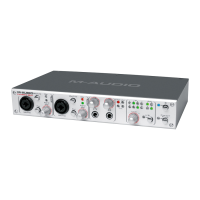to a mono instrument, set the aux output master channel’s pan knobs to <C>, or
center panned (on the output page).
As you play the synth, you should start to see level appear on the aux output master
channel as you add level to aux L control on the analog 1 in. You should also start to
see level appearing at the input of your effects unit, and hear the effect level at the
FireWire 1814’s S/PDIF In. You can make adjustments to the (effect return) monitor level
using the spdif in channel’s level faders.
To demonstrate a more advanced setup, we’ve added an effect to the instrument that
we’re recording and direct monitoring. That’s fine for recording, but we might want to
hear that same effect when we’re playing back—at least while the recording process is
going on. Once you’re done recording, you might want to disconnect the outboard
effects unit, reset your FireWire 1814 Mixer, and then use the software plug-in effects
from within your audio software.
Here’s how to hear the same effect on the synth you are recording as you hear when
playing back the track and evaluating the performance. Whichever track you are
recording to, set that track’s output to Line Output 3 and 4. In the FireWire 1814 mixer,
set the destination on sw rtn 3/4 to output bus 1/2. Then, match the level of sw rtn 3 to
the settings made earlier on the analog 1 in channel. Also, match the level of the aux L
controls for both of those channels.
This way, when you play back a track that you’ve just recorded, you’ll still hear the same
effect. This is very useful for both the artist and the producer, and is generally better for
judging the performance than having to shift your perception to listening to the recorded
track played back without an effect or with a different effect (such as one provided by a
software plug-in).
Using the Aux Send as a Separate Monitor Mix
The aux send can also be used to create an alternate monitor mix that is sent to a
headphone output. Sometimes the artist wants to hear a different mix than the recording
engineer, perhaps one with louder rhythm tracks or a quieter piano track—whatever they
need to inspire their performance.
On the output page of the control panel, select aux on the phones 2 channel. Then, on
the aux channel, set the balance to c (center), and bring both faders to zero. Open the
mixer page. Above each input and return are aux level controls for left and right. Use the
left aux send knob to send these sources to the left side of the headphones. Use the
right aux send knob to send these sources to the right side of the headphones. If you
wish to hear to source in stereo, adjust both knobs accordingly. These levels are used to
set the alternate monitor mix. Be sure to plug headphones into the phones 2 input on
the front panel, and adjust the phones 2 volume level to taste. In standard use, phones
1 is used to monitor the main mix. However, phones 1 can be used the same way as
described above.

